Connection to Baltistan
This is a recall of June 1984, thirty-nine years ago. The formation cut of a motorable road from Leh over Khardungla on the Ladakh mountain range and into Baltistan along the Shyok river valley, was completed. (The Shyok river, with source at the Rimo glacier, is a major tributary of the Indus river). The story of overcoming the major traffic bottleneck at the Khardungla ice body in 1982, has been told elsewhere. [“A Bridge and Serendipity”; Countercurrents.org; 13 June 2022] However, short of the end-point where Indian troops face Pakistani troops in Pakistan-occupied Kashmir (PoK), the Shyok river had to be bridged.
Gems discovered
The gap at the bridge centre-line was measured, and a Bailey Suspension Bridge (BSB) was planned. It would be the first BSB in Ladakh, and at an altitude of 9,000-ft. The bridge recce was completed, and the home and far bank bridge seats, anchorages, road approaches and areas to dump heavy bridging stores, were prepared, ready to receive a 280-ft BSB.
Bridging stores (BSB special parts) were inducted from the bridging stores unit at Pathankot, nearly 900-km distant, and the stores were moved to the bridge site home bank. A BSB bridging manual was procured with some difficulty, and several photocopies made for study, and preparatory familiarization and instruction.
Worryingly, however, apart from my own training on BSB equipment during an Advanced Bridging Course at the College of Military Engineering 15-years earlier, nobody I knew in the Border Roads Task Force (16 BRTF) which I was privileged to command, had any training or experience of BSB construction!
A systematic search revealed two gems, namely, Sapper Subedar Major Sardul Singh, senior JCO of a Pioneer Company, who had been a bridging instructor in the Bombay Sappers Centre, and Sapper Subedar A.S.Rao then serving in a co-located Engineer Regiment, who had been a bridging instructor in the Madras Sappers Centre. The latter was “loaned” to our BRTF by the friendly Engineer Regiment CO, for the task.
Leadership counts
The availability of knowledgeable, hands-on leaders on the home bank and the far bank allowed me to breathe a lot easier. But by far the most important factor, was Major (later Colonel) S.Ramaswamy – Ramu to his friends – being in command of the Road Construction unit (RCC) under my BRTF, with his efficient and cheerful verve. Furthermore, Ramu had led the construction of the “glacier” bridge at Khardungla in August 1982, and solved a tricky bridging problem at another bottleneck, without both of which, constructing the BSB would have been impossible.
Ramu’s RCC was committed over an extremely difficult road sector, with demanding operational requirements, and only one Sapper officer, Capt Anurag Bhargava, was available for the BSB construction. So Ramu got his RMO, AMC Capt Ashwani Kumar Kanva, as an active participant in the bridging operation, in addition to manning the MI Room at the bridge site. Both these young officers studied the BSB manual to familiarize themselves with the BSB parts, construction sequences and procedures.
Only two 4×2 load carriers and one D-80 bulldozer were available, so all logistic preparations needed meticulous planning and skilful management of severely limited resources. Ramu did this with characteristic Sapper precision, and formed and briefed the bridging teams.
On the ground
With experienced JCOs and young officers at both ends of the bridge, and four Sapper NCOs brought in from other RCCs of our BRTF, we were all set to go. The troops who would actually handle the equipment to execute the bridging task were not trained Sapper troops, but GREF Pioneers, almost all of them quite unfamiliar with bridging – exactly as during the construction of the Khardungla bridge almost two years earlier.
A camp for the bridging operations was set up on the far bank, about 2-km from the bridge site. The camp and logistics were handled by a NCO with a team comprising Shri Mahma and Shri Nathroo (aka Ghulam Haidar) hailing from Bogdang, a beautiful Balti village on the far bank, using their pack animals to carry water, food and small bridging stores to the work site.
Communications
Ramu had managed a field telephone connection at the camp, but it was in parallel with several forward posts. Calling the RCC HQ over 50-km of field line involved cranking the field telephone vigorously and telling the four or five others at forward posts who eagerly responded, to get off! It would have been fun if it didn’t require both patience and lung power. Thankfully, we had no radio, and were safe from sending daily progress reports to the Chief Engineer’s staff officer in Srinagar over 500-km away!
The existing crossing over the Shyok river was a foot suspension bridge (FSB) just upstream of the BSB centre-line. It had been constructed in 1963 by Sapper Lt Peter Mascarenhas, who had died suddenly soon after, stricken by HAPO (high altitude pulmonary odema).
With full confidence in Ramu’s command and technical capabilities, I joined the camp for the duration of the bridging operation, but refrained from involving myself in the work. I spent my time moving around, a film camera (digital cameras were still in the future) slung around my neck, taking pictures and making myself visible to the working parties on both banks, crossing and re-crossing the river several times a day over the FSB, using the precarious foot track 70-feet above the roaring Shyok river.
A brief re-wind
The FSB took only limited foot traffic, and it was impossible to get many tons of heavy Bailey bridge components across this bridge to position them on the far bank in advance. This is where Ramu’s far-sightedness and ingenuity came into play. He dedicated one of his two available 4×2 load carriers driven by an intrepid GREF driver, to ferry the BSB components over the frozen Shyok river during the preceding 1983-84 winter!
Also during the 1983-84 winter, with typical GREF elan, OEM Rulda Singh worked his D-80 bulldozer to complete the bridge approach road earthwork on both banks, driving the bulldozer over the ice of the frozen Shyok river. However, towards the end of the earthwork, when Rulda Singh was driving the bulldozer to the far bank over the ice, accompanied by three Pioneers walking alongside, the ice broke and the bulldozer sank into the flowing sub-zero water underneath.
Most fortunately, when the machine sank, Rulda Singh came up to the surface at the edge of the hole before he was swept away in the current, and he was seized by one of the men and hauled out, thus saving his life. Although drenched and cold in Ladakh’s freezing winter, Rulda Singh survived the hypothermia. He even recovered in a week, and then, in keeping with the tradition of GREF’s tough and hardy men, insisted on operating the relief D-40 bulldozer which Ramu “stole” from another sector!
The D-80 bulldozer was recovered when the ice melted in April. It was Shri Nathroo, who used his ingenuity to snag the bulldozer blade with a SWR under fast-flowing water 3-metres deep, to haul it to the far bank. Characteristic GREF grit and hard work, saw the D-80 stripped down on the far bank roadside, GREF mechanics working with bare hands warmed over a fire every couple of minutes, and got the machine serviceable before the launching of the 280-foot BSB!
A glitch and an accident
After carefully laying out and measuring the twelve SWR cables and marking the suspender locations – the stores unit did not have the regular pre-marked BSB cables, so SWRs were procured by the stores unit at Pathankot – the cables were strung over the BSB towers erected on both banks and secured in the anchorages. Construction of the home bank and far bank stiffening girders was commenced, and the girders were boomed out equally to meet at mid-span. In those times, we did not have the present-day convenience of VHF radios or mobile phones, so all communication between the banks was by whistling, hand signalling and shouting (it was often quite comical) above the sound of the fast-flowing Shyok river, or by a runner carrying important written messages across the FSB.
The Sapper NCOs were precariously perched on top of the SWR cables, two on each bank above the stiffening girders, to fix and secure the suspenders – a difficult and risky task.
Unfortunately, when the stiffening girders met at mid-span, there was a level difference between the tips of the two girders, and insertion of a Bailey pin to join the two girders was not possible. After much unsuccessful effort over most of one day, we realized that the dip in the cables and the tilt of the towers were not as prescribed in the manual.
At this point, I stepped in to order delaunching of both girders, and taking down the SWR cables to re-mark them. This critical task was very difficult as there was hardly any straight and level surface to lay out the cables to measure and mark them accurately. However, Ramu took this in hand, and it was checked and re-checked, and the cables were re-erected. This resulted in a delay of five days.
The stiffening girders were re-launched, with Ramu standing on the tip of the far bank girder. Capt Anurag Bhargava was standing on the tip of the home bank downstream girder, ready with Bailey pin and hammer in hand to perform the critical task of inserting the Bailey pin, and I stood opposite him on the upstream girder, camera at the ready to capture the moment. As the ends of the stiffening girders were about to meet, the suspender above me suddenly slipped, and I was thrown backwards against the girder, and was saved. But Capt Bhargava was thrown forward, and fell between the sway braces, down into the roaring Shyok river 70-feet below – and I, unable to do anything else at that juncture, took a picture.
Ramu’s meticulous safety arrangements came into action – the alert Safety Team immediately lowered the safety line into the water and Capt Bhargava caught it as he came up after hitting the water just seconds later, else we would have lost him, swept away in the 5-knots current.

He was hauled ashore, and dried and warmed with hot tea, and Capt Kanva’s emergency ministrations. Capt Bhargava’s soldierly fighting spirit was such that within 45-minutes he was back on site, smiling and raring to go! In the meantime, the entire bridging team was paralysed in horror to see Bhargava fall into the river. But Ramu’s leadership, Capt Kanva’s instant engagement with the problem, and Capt Bhargava’s commendable spirit got everybody back into engaging with the task of retrieving the twisted stiffening girder.
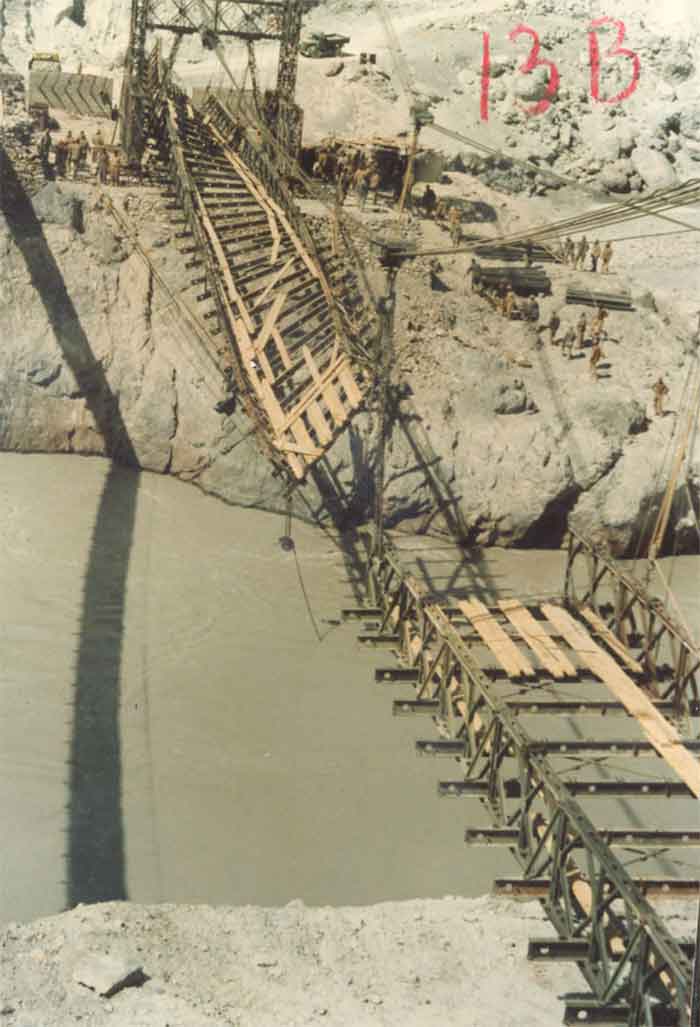
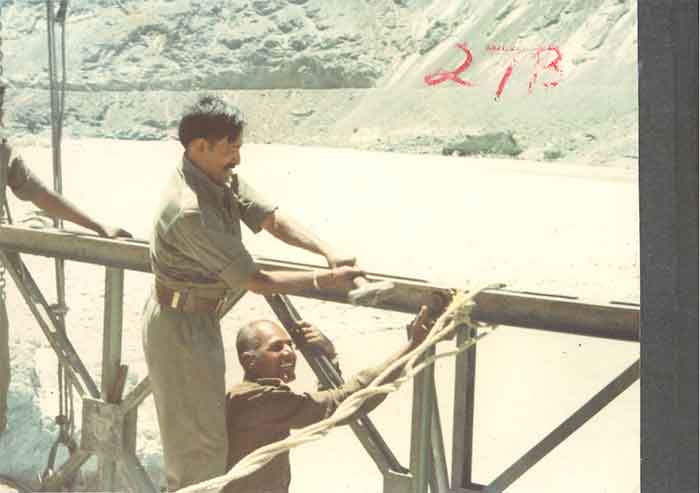
The recovery of the stiffening girders was difficult and slow, but after that the work proceeded smoothly to relaunch the stiffening girders and complete the bridge decking. However, since the sliding stringers for the ramps on both banks were not included in the BSB parts, an improvised “jugaad” solution was devised on site by cutting standard Bailey stringers and welding them.
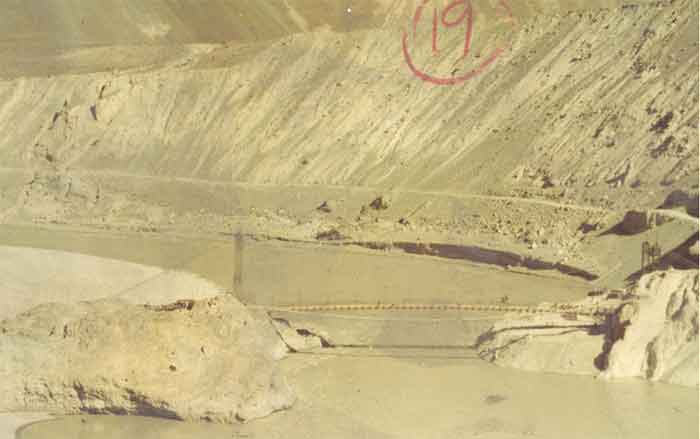
Just two days after the accident, the BSB was completed, and checked for tower tilt, roadway camber and cable dip, and our vehicles drove over the bridge. Maj Ramaswamy, Capt Bhargava, Capt Kanva, Sub Maj Sardul Singh and Sub Rao were honoured in Ladakhi tradition by tying a white ‘khatak’ around their necks.
Inauguration
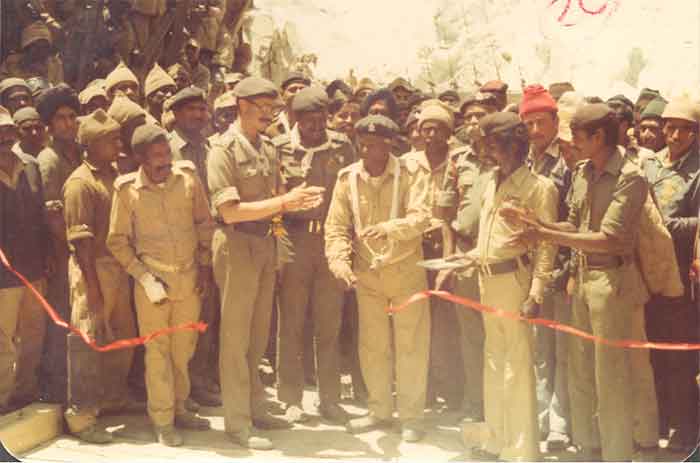
The bridge was declared open by Pnr Anandan, the oldest Pioneer at the bridge site, cutting a tape, and everyone of us thanked the Almighty for its successful completion, and for OEM Rulda Singh’s and Capt Anurag Bhargava’s safety. Boards painted “Pioneer Bridge” were erected on both ends of the bridge, and everybody including all the children of the nearby village got together for a photograph. It was celebration time at the camp that evening.
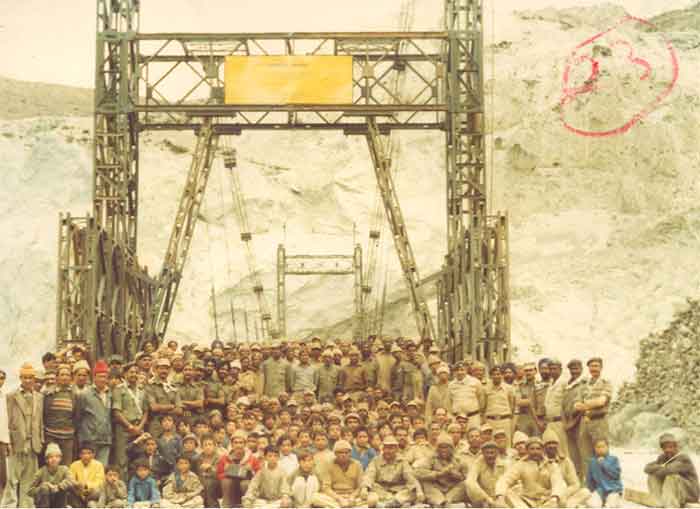
As the first-ever motor vehicle drove across Pioneer Bridge, the people of the village turned out in numbers to thank the troops for reaching them to the outside world and the outside world to them. Ladakh’s bright skies were made even brighter by the flash of teeth from smiling faces among village people and BRO men. This was another example of BRO practicing “sadbhavana” in Ladakh, as it had been doing in our northeast since 1960.
Honorary Sappers
After constructing Pioneer Bridge, the remaining restriction was the gap across Shyok just short of the end-point. This was to be bridged by a 400-ft BSB planned for construction in 1985. But a few weeks after completion of Pioneer Bridge, Ramu left the RCC on posting, and Capt Anurag Bhargava and I followed soon after on posting. Sub Maj Sardul Singh also left on posting and Sub A.S.Rao of the engineer regiment returned his unit. In short, the Sappers who had experience in constructing Pioneer Bridge were not available for the final 400-ft BSB.
However, although being a medical officer, Capt Ashwani Kumar Kanva had gained bridging experience at Pioneer Bridge, and I learned later – when I visited Ladakh in 1987 on duty connected with the Bailey bridge at Khardungla – that he was one of the key individuals during construction of the 400-ft BSB. This was of course highly commendable, but to me unsurprising, knowing Capt Kanva’s versatility as I did.
Also, I had noted during the construction of Pioneer Bridge, that Shri Nathroo, who had succeeded in rescuing the drowned D-80 bulldozer, had been very observant during its construction, and although unlettered, had made himself familiar with Bailey parts and BSB construction. I was pleasantly surprised to hear from the RCC officers that Nathroo was an important on-site technical help during the construction of the 400-ft BSB. Thus, Pioneer Bridge had produced two “honorary Sappers”, namely Capt Ashwani Kumar Kanva and Shri Nathroo!!
Epilogue
Capt Ashwani Kumar Kanva was promoted as Major, and was serving as RMO with an active unit. In 1989, when he went forward under enemy fire to render medical aid to a critically wounded infantry soldier, he was killed by enemy fire. Our army lost a good medical officer and an honorary Sapper. President of India awarded this gallant officer posthumously with VSM.
Pioneer Bridge was in regular service from 1984 to 2009, when it was delaunched, because a portion of the road was re-aligned, to avoid an unstable section of the road alignment. But the saga of Pioneer Bridge as the first BSB in Ladakh, and of the men who worked for it, demonstrates the BRO’s guiding principle of “shramena sarvam sadhyam”, translated to “everything is possible with dedicated work”.
IDENTIFYING PERSONS FOR ARCHIVAL RECORD:
PIC-1: Capt Anurag Bhargava in the fast-flowing river, holding the safety line.
PIC-2: NIL
PIC-3: From the Left: Capt Anurag Bhargava and Subedar A.S.Rao.
PIC-4: NIL
PIC-5: From the Right: Extreme Right in off-white cap, Shri Ghulam Haidar (Nathroo); In red cap, Shri Mahma; Cutting the tape, GREF Pnr Anandan with his hand bandaged for injury sustained during work; Maj S.Ramaswamy with ‘khatak’ around his neck; Capt Anurag Bhargava, bare-headed looking over Maj Ramaswamy’s left shoulder; Lt Col S.G.Vombatkere.
PIC-6: From the Left: Standing extreme Left in off-white cap, Shri Nathroo; Standing third from Left in red cap, Shri Mahma; Standing fourth from Left with ‘khatak’ but without headgear, Capt Anurag Bhargava; Standing fifth from Left with ‘khatak’ and cap, Capt Ashwani Kumar Kanva; Between and above Capt Bhargava and Capt Kanva, Sub A.S.Rao wearing a beret. From the Right: Standing extreme right, Lt Col S.G.Vombatkere; Standing second from right Maj S.Ramaswamy with ‘khatak’ around neck; Standing fourth from right, Sub Maj Sardul Singh;
Maj Gen S.G.Vombatkere retired in Sep 1996. He commanded 16 BRTF in Ladakh from April 1982 to October 1984 and was Chief Engineer Project Himank in Ladakh from May 1990 to November 1992. The President of India awarded him Visishta Seva Medal on Republic Day 1993 for distinguished services rendered in Ladakh. He holds a Masters degree in Structural Engineering from University of Pune (1974) and a PhD degree in Structural Dynamics from I.I.T Madras (1987). An ardent trekker, he has visited remote areas of Ladakh including Karakoram Pass. Settled in Mysuru, Karnataka, after retirement, he is engaged in voluntary social, environmental and civic work.
E-mail:<[email protected]>











































